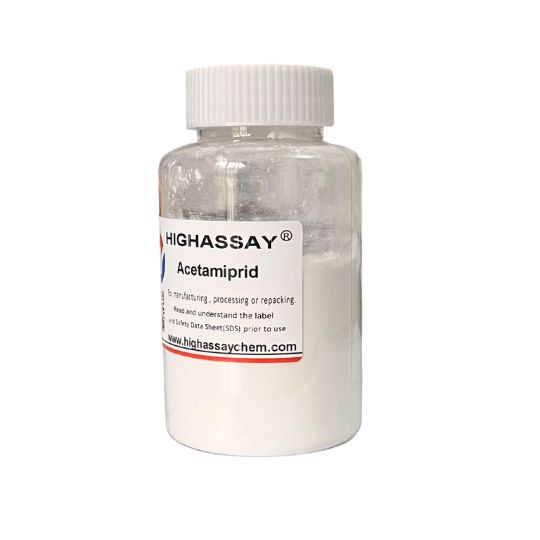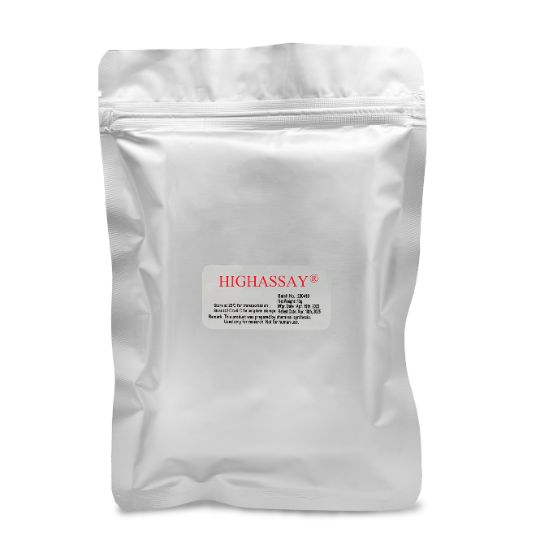A Brief Introduction to Acetamiprid
Molecular formula: C10H11ClN4
Molecular weight: 222.68
CAS No.: 135410-20-7
Appearance: White or off-white powder and liquid
Regular commercial package: 25kg/drum
What is Acetamiprid?
Acetamiprid is a new type of pyridine pesticide, also known as Acetamiprid thiazolinone. It achieves over 90% control efficacy against specific pests (such as aphids, leafhoppers, and whiteflies), and is particularly effective against some resistant pests. It is estimated that there are over 700 products containing acetamiprid, including both technical grade and formulations. Developed by Nippon Soda Corporation in 1996, it remains in use today.

Why choose Highassay?
Highassay offers solid forms in various purities and liquid forms in various concentrations (see the table below for detailed information), which can be used in the production and processing of various insecticide products. Please select the appropriate Acetamiprid raw material according to your specific needs. If you encounter any problems during production or use, please contact the Highassay team for the most professional advice.
Benefits of Acetamiprid
- Acetamiprid has good miscibility. When mixed with other ingredients, its effectiveness is enhanced and it is less likely to induce resistance.
- Acetamiprid has contact and stomach toxicity. Insecticidal effects can be seen in a short time, and the duration of effect is long.
- Acetamiprid is relatively safe. It is relatively safe for humans, livestock, and natural enemies of pests when not in contact with or ingested for extended periods.
- Acetamiprid has broad-spectrum activity and strong penetrability. It kills pests by penetrating the plant and being ingested by them.


Acetamiprid VS Imidacloprid
Both Acetamiprid and Imidacloprid are highly effective insecticides against piercing-sucking pests. However, they differ in terms of retention time, temperature sensitivity, and speed of action. For example, Imidacloprid has a longer retention time than Acetamiprid; Acetamiprid’s effectiveness increases with temperature, while Imidacloprid is less affected by temperature; and Acetamiprid takes effect faster than Imidacloprid. Therefore, it is recommended that you choose the appropriate product based on your specific needs.
The Relationship Between Acetamiprid and Bifenthrin
The combination of acetamiprid and bifenthrin is a classic and highly effective formulation. Their synergistic effect solves almost all crop pest problems, achieving a powerful combined effect. It reduces the dosage and enhances the effect compared to using either ingredient alone; simultaneously, the combination effectively prolongs the time it takes for pests to develop resistance; and it also significantly reduces labor and material costs.

Applications of Acetamiprid
Highassay adheres to strict quality control (QC) to produce Acetamiprid. Buy Acetamiprid in bulk from us now to get competitive market prices.
This is the most common application method for Acetamiprid products. Firstly, this method requires diluting the Acetamiprid product with a large amount of water. It is suitable for various formulations and reduces pesticide usage, saving costs. Secondly, spraying ensures even coverage of the crop surface, maximizing efficacy. Finally, advanced spraying equipment can be used, allowing for quick and effective application over large areas.
This is less common, but it offers several advantages over spraying. Firstly, it is simple to operate, requiring no special equipment. Secondly, it is more suitable for paddy fields, large-scale soil treatments, and water-scarce areas. Finally, broadcasting is almost unaffected by weather conditions, especially strong winds.
Specifition of Acetamiprid
- Specifition of Acetamiprid
| Product Name | Acetamiprid |
| Chemical name | E-N’-[(6-Cl-3-pyridyl)methyl]-N’(2)-cyano-N’-methyl-acetamide |
| Melting point | 101℃-103.3℃ |
| Boiling point | 352.4℃ |
| Water soluble | Soluble in water, solubility increases with temperature |
| Density | 1.17Kg/m³ |
| Flash point | 166.9℃ |
| Storage | Store in ventilating and dry warehouse, avoid sunshine. |
| Formulations | 95%Tech, 20%SL, 5%、25%EC, 40%WDG, 20%WP |
| Package | 25kgs fiber drum, 200L drum, various bottles |
It is effective, but it is not specifically designed for fleas. It is recommended that you choose a dedicated flea treatment or seek veterinary help.
Compared to other types of insecticides, Acetamiprid is not very harmful.
The green twig borer is a boring pest that damages tree trunks and branches. Trunk injection of Acetamiprid is a completely feasible and highly effective method. It is also environmentally friendly, unaffected by weather, and saves water and labor.
Precautions for using Acetamiprid:
- When using insecticides like Acetamiprid, a safe interval must be allowed regardless of the frequency of application or crop harvest. This effectively prevents excessive pesticide residues in crops and reduces environmental pollution.
- In addition to personal safety, avoid polluting water and soil during contact with or use of Acetamiprid products or during the production of finished products containing Acetamiprid.
- Acetamiprid is highly toxic to silkworms. Therefore, Acetamiprid-containing insecticides must not be used in silkworm farming areas, and Acetamiprid-related products should not be used or washed in water sources near silkworm farms.
- Acetamiprid should not be mixed with alkaline ingredients. Mixing with alkaline products will cause a hydrolysis reaction, easily rendering the Acetamiprid ineffective and resulting in crop losses and wasted resources.
- Use strictly according to the label instructions and keep out of reach of children.







